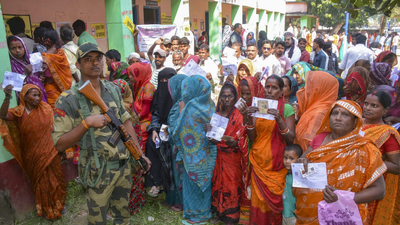ARTICLE AD BOX

PATNA: Bihar set a new record on Tuesday with a polling percentage of 68.8 in the second and final phase, leaving political parties in a state of nervous excitement. The overall voting for both phases stood at 66.9%, the highest overall turnout since 1951.
In the 2020 assembly polls, the turnout was 57.3% over three phases. While the opposition has termed it a mandate against NDA, the governing alliance sees it as a vote of confidence in the Nitish Kumar-led double-engine govt. Scenes of polling officials being greeted with garlands and drumbeats dominated areas that were once under the grip of Maoist violence, with long queues from early morning surprising EC officials.
While 62.8% male voters participated in the polling, the turnout among female voters was recorded at 71.6%.
According to EC, the previous highest turnout in the state was 64.6%, recorded during the 1998 LS polls, while in assembly polls, it was 62.6% in 2000.1,592 poll booths located in Maoist-hit areas, none of them shifted this time The Bihar Legislative Assembly elections concluded with a historic highest-ever voter turnout of 66.9%. This is the highest voter turnout recorded in the state since 1951," chief electoral officer (CEO) Vinod Singh Gunjiyal told a media conference on Tuesday evening.
Contrary to speculations that the heightened security and rigorous checks following the Delhi terror blast on Monday evening could impact voting, the polling percentage remarkably shot up in 122 assembly seats in 20 districts that went to polls in the second phase. Muslim-domianted Seemanchal region comprising four districts of Kishanganj, Purnia, Katihar and Araria saw highest voting. "The second phase of polling passed off peacefully, as no incident of violence was reported from anywhere," Gunjiyal said, adding that all the vehicles and boats carrying EVMs were fitted with GPS systems to track their movement. A total of 1,592 booths were located in the Maoist-affected areas, and none of them had to be shifted this time. In a proud moment for Chormara village in Barhat block of once Naxal-hit Jamui district, a team of polling personnel was accorded a grand welcome with rhythmic drum beats, traditional folk songs and garlands of marigold flowers. The festive mood lingered, with streets buzzing with excitement and anticipation throughout the day.
In the same district, the wife of a surrendered Maoist commander, Arjun Koda, reached a polling booth to cast her vote and also posed for photographs. The polling was marked by vibrant scenes adding colour to the festival of democracy. At Amuar booth in Supaul district, a patient fitted with an oxygen cylinder came in an e-rickshaw to exercise his franchise. A centenarian woman was carried to a polling booth on a wooden rope cot by her relatives at Amarpur village.
Raju Kumar, a resident of Bhagat Tola in Araria district, arrived to cast his vote prostrating all the way.
In nearby Terhagachh block in Kishanganj district, dozens of villagers navigated waist-deep water as they crossed a river to reach the polling station. Over the two-phased elections, more than 8.5 lakh polling staff, over 1.4 lakh polling agents of 2,616 candidates, 243 general observers, 38 police observers and 67 expenditure observers were part of the election machinery, the Election Commission said. The CEO said they received a total of 230 complaints that were promptly addressed. It was also for the first time that webcasting of voting was done at all the booths.

 1 hour ago
5
1 hour ago
5








 English (US) ·
English (US) ·